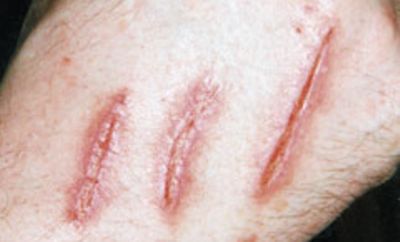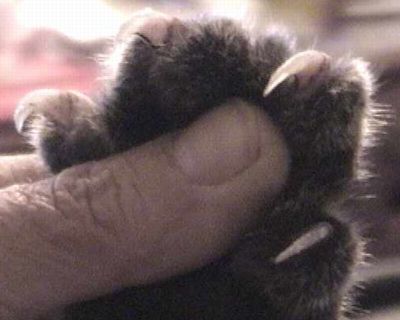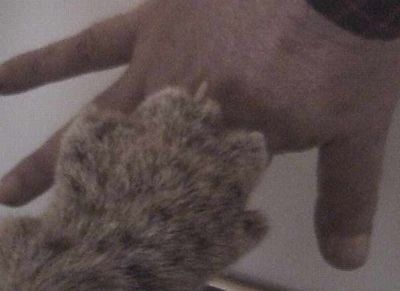
Report from Neil Arnold of Kent Big Cat Research
Please send us your comments on the following photos 
Man scratched by lynx in Kent

During January 2002 a man from Gravesend, Kent, had his hand scratched by a Lynx after approaching it in order to prise a rabbit from its jaws. The victim of the attack was quick to add that he was wrong to approach the animal and that the feline in question was only defending itself. However, such a story has been plastered all over the internet, which immediately threatens such an animal and its territory and brings unwanted attention on the witness. These stories are not extravagant headlines but merely turn these animals into 'beasts'. The last thing we need is trigger happy people stalking back gardens and woodlands, hoping to take a pop at a Lynx.
Stories like this are blown out of proportion, and despite being 'old hat', are constantly churned out like some kind of exaggerated reminder which certainly does not have the welfare of the animals in mind. Attacks WILL occur if people approach, corner or injure animals, but such an incident should be subdued in order to protect the feline in question..
Neil Arnold, Kent Big Cat Research.
I am very grateful to Neil for updating his comments and agree wholeheartedly with them.
There has been some ill-informed comment in the press concerning this "terrifying" attack with self-styled big cat experts seeking cheap publicity by the use of sensational press releases. It is important that the general public understand the reality of any threat from lynx.
These animals pose no danger to people unless provoked in some way. Unlike the brown bear or wolf, there are not even anecdotes about man-eating lynx. The very few cases where lynx have injured humans have all been incidents with wounded, captured, or rabid lynx. There is no report of any spontaneous attack of a lynx; even females pushed away from their litters do not defend their cubs. They will, however, attack dogs approaching the kittens, even if the dog is accompanied by people.
I found the wounds inflicted to be extremely "clinical" - exact parallel lines and not at all what I would have expected from scratch marks by a lynx.
Dr Christina Anne Smith, Publications Officer, Scottish Big Cats


As can be seen in the images, the lynx claws cannot lacerate in the fashion seen on the alleged victim's hand. These claws puncture rather than scratch or lacerate. Their primary purpose is for holding prey rather than as weapons. They move independently, and are formed around the paw. In order for the first and forth claw to scratch the flesh, the second and third would pentrate more than an inch deep . This is quite evident in the photo showing my own hand in front of the lynx paw.
According to the victim's account of the incident, he had seen an animal that he believed to be a fox. The supposed fox had captured a tame rabbit and was in the process of carrying it away. He approached the animal in an effort to remove the rabbit, then realized he had encountered a lynx. It was then that it lashed out, striking his hand.
A lynx would never place itself in a situation of being cornered. They are capable of leaps of eight feet straight up. Nothing can sneak-up on an unsuspecting lynx, not even another lynx. If approached, and unable to flee, the lynx has a ferocious growl that would discourage a grizzly-bear. No one would be foolish enough to extend their hand toward a feeding lynx, not even the most docile of pets.
A number of the alleged attacks in Britain have been dubious. In the Josh Hopkins incident, the marks could have been made by brambles as he was escaping from the alleged leopard. With Sally Dyke, a cat might have caused the marks if she held her arm upright long enough for the cat to make two strikes. In the lynx incident, I can think of no similar explanations which discount would discount a hoax.
Ben Willis, President, Scottish Big Cats
If there are no stitch holes on either side of those claw
marks then if the slight scratches were made by a lynx,
the lynx was really holding back to just say no.
I have a norwegian wood cats that was feral and she
eats rabbits, head and all. If she says no with her
teeth and claws like a mother cat with kittens and
if I got scared and moved my hand I would get
scratches but otherwise not at all. I believe the lynx
was trying hard not to do anything but say no and
some degree of damage was caused by the person
being scared, understandably.
I do not believe it's possible to mistake a lynx
for a fox, though, so maybe it's a hoax. Or
maybe it was a large norwegian wood cat pet
not used to humans taking away its lunch but
used to them approaching. They can look more
like foxes, and foxes look like cats.
Maybe it was a fox, with claws as DULL as
that.
Bob.

The rabbit seen in the photo, and being held by Exmoor
the bobcat was undoubtedly killed by a cat, but not
the cat in this image.
Saturday morning, as I was moving some broken branches
with a tractor, I found this rabbit lying dead, still
warm and obviously killed only
minutes earlier. On the rump were the typical marks
of a bobcat's claws in bringing it down. The neck
was also broken without the slightest sign of any
punctures. Next the rib-cage, there was a large
section
of abrasions from the cat's tongue
in removing the fur. This area was still wet from
saliva, so the cat was apparently only minutes away.
Rather than waste the carcass, I gave it to Exmoor
to practice her predatory skills, and have a taste
of rabbit that she's never had. After playing for
an hour, and giving me some good video images, she
began to consume the rabbit in the same fashion as
a wild bobcat would. After a long taste, she
immediately gave up the rabbit in exchange for some
ham and cheese. If they only made cold-cuts in the
shape of animals.
It is rare to find predated animals in this pristine
condition just after a kill. It also makes for a good
example of the cat's killing methods.
Ben Willis, President, Scottish Big Cats
I thought this one had died a death along with the "attack" on the young boy
in the Welsh borders.
I think the man's name was Mick Cole and he:
a) thought that a cat without a tail was a fox with a brush, and
b) thought a fox would happily let him take his dinner away from him
At the time I thought this story was riddled with inconsistencies, and it
hasn't aged well at all. I think Ben's photos help explain why we all had
doubts back then.
Phil Crosby
 |
 |
 |
| Return to index | Return to Scottish Big Cats | Return to Photo Album |